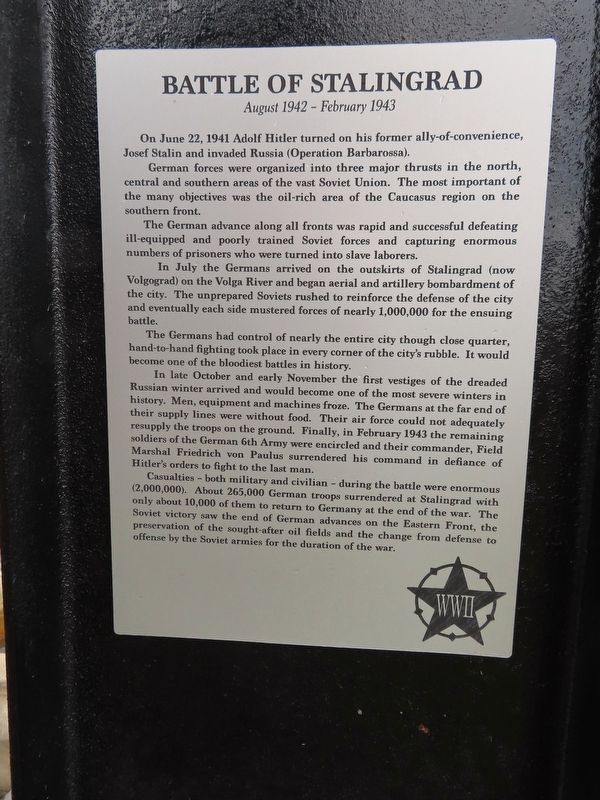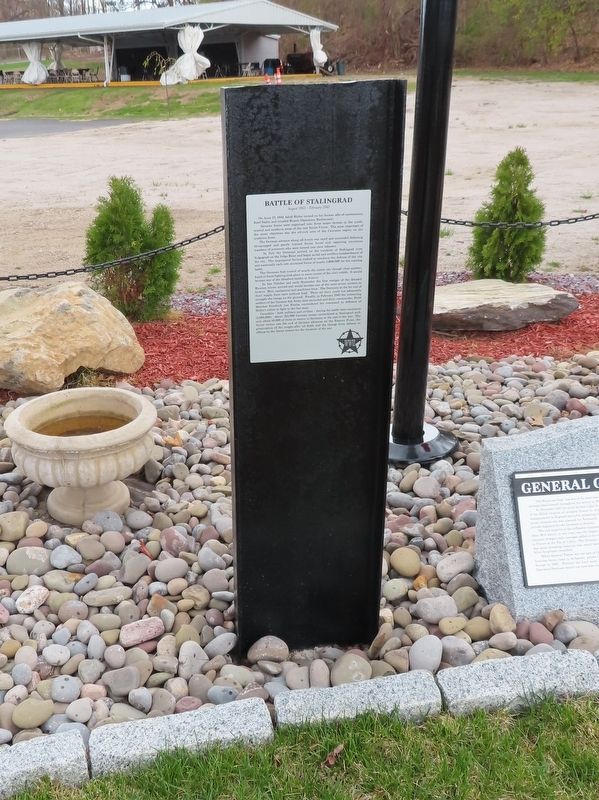Woonsocket in Providence County, Rhode Island — The American Northeast (New England)
Battle of Stalingrad
August 1942 - February 1943
German forces were organized into three major thrusts in the north, central and southern areas of the vast Soviet Union. The most important of the many objectives was the oil-rich area of the Caucasus region on the southern front.
The German advance along all fronts was rapid and successful defeating ill-equipped and poorly trained Soviet forces and capturing enormous numbers of prisoners who were turned into slave laborers.
In July the Germans arrived on the outskirts of Stalingrad (now Volgograd) on the Volga River and began aerial and artillery bombardment of the city. The unprepared Soviets rushed to reinforce the defense of the city and eventually each side mustered forces of nearly 1,000,000 for the ensuing battle.
The Germans had control of nearly the entire city though close quarter, hand-to-hand fighting took place in every corner of the city's rubble. It would become one of the bloodiest battles in history. In late October and early November the first vestiges of the dreaded Russian winter arrived and would become one of the most severe winters in history.
Men, equipment and machines froze. The Germans at the far end of their supply lines were without food. Their air force could not adequately resupply the troops on the ground. Finally, in February 1943 the remaining soldiers of the German 6th Army were encircled and their commander, Field Marshal Friedrich von Paulus surrendered his command in defiance of Hitler's orders to fight to the last man.
Casualties - both military and civilian - during the battle were enormous (2,000,000). About 265,000 German troops surrendered at Stalingrad with only about 10,000 of them to return to Germany at the end of the war. The Soviet victory saw the end of German advances on the Eastern Front, the preservation of the sought-after oil fields and the change from defense to offense by the Soviet armies for the duration of the war.
Topics. This memorial is listed in this topic list: War, World II. A significant historical month for this entry is February 1943.
Location. 42° 0.443′ N, 71° 31.697′ W. Marker is in Woonsocket, Rhode Island, in Providence County. Memorial is on River Street north of 2nd Avenue, on the left when traveling north. Located next to American Legion Fairmount Post 85. Touch for map. Marker is at or near this postal address: 870 River Street, Woonsocket RI 02895, United States of America. Touch for directions.
Other nearby markers. At least 8 other markers are within walking distance of this marker. General George S. Patton, Jr. (here, next to this marker); Battle of the Bulge (here, next to this marker); D-Day (here, next to this marker); Battle of Midway (here, next to this marker); World War II Ends (here, next to this marker); Pearl Harbor (here, next to this marker); Major John T. Godfrey (here, next to this marker); Battle of Britain (here, next to this marker). Touch for a list and map of all markers in Woonsocket.
Credits. This page was last revised on May 6, 2022. It was originally submitted on May 6, 2022, by Michael Herrick of Southbury, Connecticut. This page has been viewed 83 times since then and 15 times this year. Photos: 1, 2, 3. submitted on May 6, 2022, by Michael Herrick of Southbury, Connecticut.


